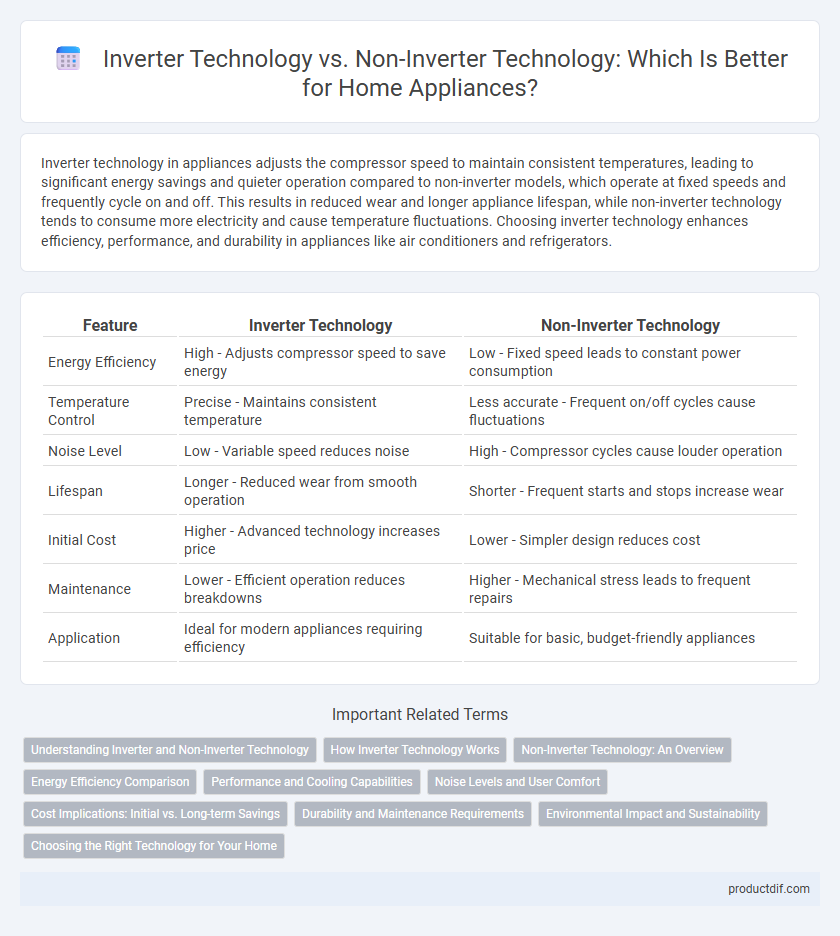Inverter technology in appliances adjusts the compressor speed to maintain consistent temperatures, leading to significant energy savings and quieter operation compared to non-inverter models, which operate at fixed speeds and frequently cycle on and off. This results in reduced wear and longer appliance lifespan, while non-inverter technology tends to consume more electricity and cause temperature fluctuations. Choosing inverter technology enhances efficiency, performance, and durability in appliances like air conditioners and refrigerators.
Table of Comparison
| Feature | Inverter Technology | Non-Inverter Technology |
|---|---|---|
| Energy Efficiency | High - Adjusts compressor speed to save energy | Low - Fixed speed leads to constant power consumption |
| Temperature Control | Precise - Maintains consistent temperature | Less accurate - Frequent on/off cycles cause fluctuations |
| Noise Level | Low - Variable speed reduces noise | High - Compressor cycles cause louder operation |
| Lifespan | Longer - Reduced wear from smooth operation | Shorter - Frequent starts and stops increase wear |
| Initial Cost | Higher - Advanced technology increases price | Lower - Simpler design reduces cost |
| Maintenance | Lower - Efficient operation reduces breakdowns | Higher - Mechanical stress leads to frequent repairs |
| Application | Ideal for modern appliances requiring efficiency | Suitable for basic, budget-friendly appliances |
Understanding Inverter and Non-Inverter Technology
Inverter technology in appliances adjusts compressor speed to regulate temperature efficiently, reducing energy consumption and providing consistent performance. Non-inverter technology operates with a fixed compressor speed, leading to frequent on/off cycles that consume more power and cause temperature fluctuations. Understanding this distinction helps consumers choose appliances that offer better energy savings and enhanced durability.
How Inverter Technology Works
Inverter technology in appliances adjusts the compressor speed based on the cooling demand, allowing precise temperature control and improved energy efficiency. Unlike non-inverter models that operate at a fixed speed, inverter systems continuously regulate power consumption, reducing energy waste and maintaining consistent performance. This technology enhances durability and reduces wear by minimizing frequent start-stop cycles.
Non-Inverter Technology: An Overview
Non-inverter technology operates appliances by running the compressor at a fixed speed, resulting in consistent but less energy-efficient performance. This technology is commonly found in traditional air conditioners and refrigerators, where the compressor switches on and off to maintain the desired temperature. Non-inverter systems typically have higher electricity consumption and generate more noise compared to inverter-based appliances.
Energy Efficiency Comparison
Inverter technology in appliances adjusts the compressor speed to maintain optimal temperature, significantly reducing energy consumption compared to non-inverter models that operate at a fixed speed. Energy efficiency ratings for inverter appliances often show savings of up to 30-50%, making them more cost-effective and environmentally friendly over time. Non-inverter appliances typically have higher electricity bills due to frequent on-off cycling, leading to increased energy waste and wear on components.
Performance and Cooling Capabilities
Inverter technology in appliances optimizes performance by continuously adjusting compressor speed, resulting in efficient energy use and consistent cooling temperatures. Non-inverter technology operates at fixed speeds, causing more frequent temperature fluctuations and higher energy consumption. Inverter systems provide faster cooling, quieter operation, and enhanced durability compared to traditional non-inverter units.
Noise Levels and User Comfort
Inverter technology in appliances significantly reduces noise levels by adjusting motor speed to operate efficiently, resulting in quieter performance compared to non-inverter models that run at constant, louder speeds. This noise reduction enhances user comfort by minimizing disturbance during operation, making inverter appliances ideal for environments where silence and tranquility are valued. The smoother operation of inverter technology also contributes to less vibration and prolonged appliance lifespan, further improving overall user experience.
Cost Implications: Initial vs. Long-term Savings
Inverter technology appliances typically have higher upfront costs compared to non-inverter models due to advanced components like variable speed compressors. However, inverter appliances deliver significant long-term savings by consuming less energy and reducing electricity bills through precise power regulation. Non-inverter appliances may save money initially but lead to higher operating costs over time due to fixed-speed compressors and inefficient energy use.
Durability and Maintenance Requirements
Inverter technology appliances typically offer enhanced durability due to their ability to adjust motor speed, reducing wear and tear compared to non-inverter models that operate at a constant speed. Maintenance requirements for inverter appliances are generally lower since the flexible operation minimizes component stress and extends the lifespan of critical parts such as compressors and motors. Conversely, non-inverter technology often demands more frequent servicing and part replacements due to the constant on-off cycling that strains mechanical components.
Environmental Impact and Sustainability
Inverter technology significantly reduces energy consumption by adjusting compressor speed to match cooling demand, leading to lower greenhouse gas emissions compared to non-inverter appliances that operate at fixed speeds. This energy efficiency translates into reduced carbon footprints and decreased reliance on fossil fuels, promoting environmental sustainability. Furthermore, inverter appliances often have longer lifespans and enhanced durability, which minimizes electronic waste and resource depletion during product lifecycle.
Choosing the Right Technology for Your Home
Inverter technology offers precise temperature control and energy efficiency by adjusting compressor speed, which reduces electricity consumption and extends appliance lifespan. Non-inverter appliances operate at a constant speed, leading to higher energy use and more wear over time. Choosing inverter technology for your home ensures lower utility bills and eco-friendly performance, making it ideal for long-term savings and sustainability.
Inverter Technology vs Non-Inverter Technology Infographic

 productdif.com
productdif.com